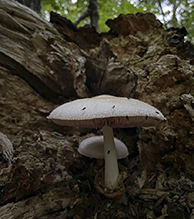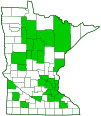Silky Rosegill
(Volvariella bombycina)
Conservation • Description • Habitat • Ecology • Distribution • Taxonomy
Conservation Status |
|
|||||||
| IUCN Red List | not listed |
|||||||
| NatureServe | NNR - Unranked |
|||||||
| Minnesota | not listed |
|||||||
Description |
||
Silky Rosegill is a widespread and conspicuous but uncommon, medium-sized to large, edible, gilled mushroom. It occurs in Europe, North America, and Central America, and there are scattered reports of it in east Asia and Africa. In the United States it is most common east of the Great Plains. It is found in deciduous and mixed woodlands. It appears from July through October, usually alone, sometimes close together but not clustered, in standing, living or dead hardwood trees, stumps, and logs. It grows on dead hardwood and on the wounds of living trees. It obtains its nutrients from dead and decaying wood (saprobic). When it first appears, the fruiting body is enveloped in a thick, egg-shaped, protective covering (universal veil). The surface of the universal veil is white and often cracked into brownish, irregularly-shaped blocks. The fruiting body soon bursts through and expands into a stalked mushroom. The cap is white and is bell-shaped or convex at maturity, becoming yellowish or brownish and nearly flat in old age. The mature cap can be 2″ to 8″ (5 to 20 cm) in diameter but is usually no more than 4¾″ (12 cm) wide. The upper surface is dry, white to yellowish, and densely covered with long, silky, hair-like fibers (fibrillose). This is the feature that gives the species its common name. The stalk is white, dry, smooth, and firm. It is often curved to hold the cap parallel to the ground. It can be 2⅜″ to 8″ (6 to 20 cm) long and ⅜″ to 13⁄16″ (1 to 3 cm) thick, but it is usually no more than 6″ (15 cm) long. The universal veil persists as a deep, white to yellowish or brownish, sac-like cup (volva) at the base of the stalk. The gills are not attached to the stalk (free). They are broad, crowded, and white when young, becoming flesh-colored or pink at maturity. This is the feature that gives the genus its common name. The flesh is thin, white, and soft. It does not change color when sliced. It is edible and according to one mycologist is “worth eating if found in large enough quantities.” The spore print is pink. |
||
Similar Species |
||
Habitat and Hosts |
||
Deciduous and mixed woodlands Hardwood trees, stumps, and logs |
||
Ecology |
||
Season |
||
July through October |
||
Distribution |
||||
|
Sources |
|||
| 8/8/2022 | ||||
Occurrence |
||||
Uncommon |
||||
Taxonomy |
|||
| Kingdom | Fungi (Fungi) | ||
| Subkingdom | Dikarya | ||
| Phylum | Basidiomycota (Basidiomycete Fungi) | ||
| Subphylum | Agaricomycotina (Higher Basidiomycetes) | ||
| Class | Agaricomycetes (Mushrooms, Bracket Fungi, Puffballs, and Allies) | ||
| Subclass | Agaricomycetidae | ||
| Order | Agaricales (Common Gilled Mushrooms and Allies) | ||
| Suborder | Pluteineae | ||
| Family | Pluteaceae | ||
Genus |
Volvariella (rosegills) | ||
Subordinate Taxa |
|||
Silky Rosegill (Volvariella bombycina var. bombycina) Silky Rosegill (Volvariella bombycina var. laviceps) Silky Rosegill (Volvariella bombycina var. microspora) Silky Rosegill (Volvariella bombycina var. palmicola) |
|||
Synonyms |
|||
Agaricus bombycina Agaricus bombycinus Agaricus denudatus Pluteus bombycinus Volvaria flaviceps Volvariopsis bombycina |
|||
Common Names |
|||
Silky Rosegill Silky Sheath Silky Volvariella Silver-silk Straw Mushroom Tree Mushroom |
|||
Glossary
Fibrillose
On mushrooms, covered with fine hair-like fibers.
Saprobic
A term often used for saprotrophic fungi. Referring to fungi that obtain their nutrients from decayed organic matter.
Universal veil
An egg-like structure that envelopes all or most of a developing gill mushroom. Remnants of the universal veil sometimes visible on a mature mushroom are patchy warts on the cap, a ring on the stalk, and a volva at the base of the stalk.
Volva
Also called cup. A cup-like covering at the base of a mushroom stem, sometimes buried. In Amanita, Volvariella, and some other mushrooms, it is the remnants of the universal veil ruptured by the mushroom pushing through. In Phallales it is the remnants of the ruptured peridium.
Visitor Photos |
|||||
Share your photo of this fungus. |
|||||
| This button not working for you? Simply email us at info@MinnesotaSeasons.com. Attach one or more photos and, if you like, a caption. |
|||||
Honey Fae (Farah) |
|||||
Silky sheath are uncommon in Minnesota, species of Rosegills. |
|||||
 |
|||||
MinnesotaSeasons.com Photos |
|||||
|
|||||

Slideshows |
||

Visitor Videos |
|||
Share your video of this fungus. |
|||
| This button not working for you? Simply email us at info@MinnesotaSeasons.com. Attach a video, a YouTube link, or a cloud storage link. |
|||
Other Videos |
|||
| Identifying the Volvariella bombycina, Silky Rosegill Wild Food in the UK Ltd |
|||
About
Jul 16, 2019 This is a lovely find when out spotting mushrooms, but is not to be collected due to its rarity. Identification by www.wildfooduk.com |
|||
| Volvariella bombycina Pilz Kultur |
|||
About
Jul 25, 2013 Für mich einer der schönsten u. faszinierensten Pilze ! Gestern gefunden auf einer alten Eiche , insgesamt 12 Fruchtkörper :-) ! 3 Exemplare wurden für Zuchtversuche mitgenommen. http://www.pilz-kultur.at Google Translate: For me one of the most beautiful and fascinating mushrooms! Found yesterday on an old oak tree, a total of 12 fruiting bodies :-)! 3 copies were taken for breeding attempts. |
|||
| Volvariella Bombycina Shroom in Panmurefield Forest 5/8/17 Paul Morgan |
|||
About
Aug 6, 2017 At the Seven Arches |
|||
| Tree Volvariella (Volvariella bombycina) Tony Henneberg |
|||
About
Jul 13, 2019 Tree Volvariella, discovered in an old oak tree on September 19, 2018. In 2019, a single mushroom grew and was harvested on July 1. Three mushrooms were harvested on July 13th. Perhaps there will be more. Northern Dutchess County, New York. |
|||

Visitor Sightings |
|||||
Report a sighting of this fungus. |
|||||
| This button not working for you? Simply email us at info@MinnesotaSeasons.com. Be sure to include a location. |
|||||
| Honey Fae (Farah) 7/9/2022 |
Location: Hennepin County Silky sheath are uncommon in Minnesota, species of Rosegills. |
||||
MinnesotaSeasons.com Sightings |
|||||
|
|||||

Created: 8/8/2022
Last Updated:

